
NFL Combine Trainer: 40-Yard Dash For Pure Athleticism
Many athletes think they are fast, but are they NFL fast? The 40-yard dash measures pure athleticism. Fractions of seconds separate first-round talent from the undrafted.
Overview | Next Drill
The 40-yard dash is the most popular event at the NFL Combine each spring. When grown men are chasing you down, hell-bent on hitting their tackles bonus, only speed will save you. How fast can you accelerate from a dead stop to full speed? Pro scouts look at all parts of the 40, from the acceleration in the first 10 yards to the photo finish.
The stopwatch identifies likely touchdown-scoring millionaires. It makes others re-think post-collegiate job offers back home in Georgia, the family business in California, perhaps law school for that Ivy League QB who thought he had a shot at the shield.
I look at it as another tool. It is the Holy Land of pure athleticism.
NFL Combine Trainer 40-Yard Dash
Watch the video: 18:53
8 Training Exercises For The 40-Yard Dash
See video above for exercise demonstrationsAnkling-to-Butt Kick Series

Ankling is the first part of absolute speed training. During the first part of the 40, your body will be in a forward lean and your legs will be going through a piston-like action.
Step-By-Step: First 5 Yards
- Push toe to top of sneaker
- Lock ankle
- Move forward
- Keep arm action in line
- Make sure hand breaks waist/hip
- Head is going to be tucked
- Move forward for five yards
- 5 yards completes the cycle
- Full range all the way down and foot will clear the opposite ankle
"Eventually gravity dictates that your body has to stand up. When you do that, you might not actually be traveling at your true, absolute speed potential, but your leg is now going through a cyclical action, not a piston action. We call that 'absolute speed mechanics'."
Step-By-Step: Last 5 yards
- 5 yards of Butt Kick
- The range increases
- 10 yards completes the cycle
- Rest period is the walk back
- Do 2,3,4,5 cycles ... depending on how the athlete responds to the activity
"If you're looking at the absolute speed mechanic, or that cyclical pattern, the Ankling-to-Butt Kick series is the first progression to competently teach that type of leg motion."
Absolute Speed A-Run Series
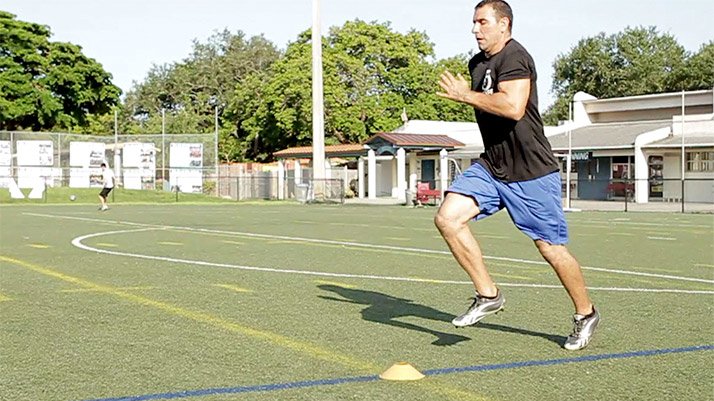
The next progression is the A-Run. Ankling initiates that recovery phase that happens as soon as your foot comes off the ground in that cyclical pattern. You want to reduce that time as much as possible in order to get quickly into your recovery phase.
The A-Run not only completes the cycle, but after you transition to the top, it gets into a ground preparation phase.
Step-By-Step: 30 total yards: 10 yards fast jog; 20 yards accelerated A-Run
- Start off at first cone
- 10-yard build-up jog, then ...
- Combine the components of Ankling and a Butt Kick:
- Push toe to top of sneaker
- Head is tucked
- Pull that ankle through
- Increase to the Butt Kick
- Hands push through
- Give leg a full cycle reflex to the front
- 3-5 reps ... depending how the athlete looks in the drill
We're training Ankling/Butt Kick, coming back around to that cyclical pattern of the leg action, into that A-Run.
Moving Claw Series

The Moving Claw Series is the best ground preparation phase that ties it all together. Your leg can actually travel through the air at almost an identical speed of when you're running at that absolute speed mechanically, from the 20-to-40-yard line.
Step-By-Step: Lower body
- Push toe to the top of the sneaker
- Butt Kick all the way to the top
- Clear the knee
- Relax the quad
- Attack the ground
Step-By-Step: Upper Body/Arms
- Give it a rapid 1-2 motion
- Punch and follow through
- Don't leave the arms behind!
The exercises tie into each other. I wouldn't say one exercise progresses into the next one, but if you're efficient at Ankling, you can be more efficient in Butt Kicking. If you're more efficient in Butt Kicking, you're more efficient in A-Run. If you're more efficient in the A-Run, you're more efficient in the Moving Claw Series.
Alternate legs; be balanced
You're not joint loading and moving fast-forward, you're just undergoing the properties of that powerful leg whip around the cycle of what happens when your foot comes off the ground until your foot comes into the ground.
When you start to master the complexities of the moving claw series ... we start to see the transfer of athletes starting to run like their body is intended to run through the all-important finishing point of the 40.
It's one thing to do drills. It's another thing to do drills that will actually apply to your running form without the athlete thinking about it. Typically, when we start to see the mastery of the Moving Claw Series, we start to see that transfer.
Prowler Sprint
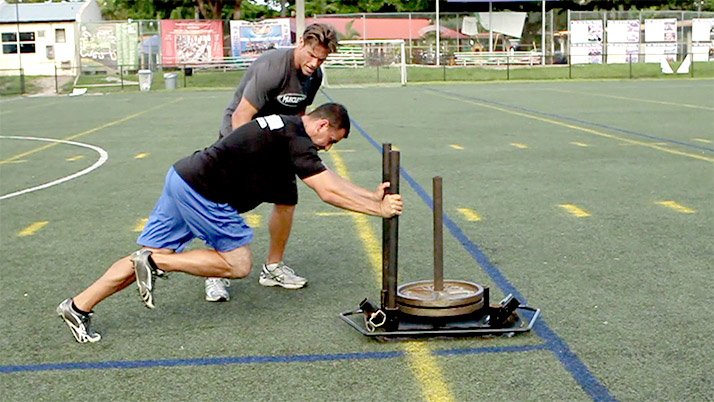
Pure acceleration is the goal. As soon as you come off the line, your body is in that forward lean, with your legs moving through that piston-like action.
Strength, especially high-speed strength, greatly enhances that motion.
Step-By-Step: 10-yard Prowler Sprint
- Walk to prowler
- Place hands mid-to-top on bars
- Feet together
- Ankles locked
- Toes pushed to the top of the sneaker
- Engage glutes
- Hold for 5 seconds ... Go!
- Knee-up, piston action
- Knee-action in front of body
- No Butt Kick whatsoever
- Accelerate forward
- Rest ... 10, 20, 40 yards ... rest ... increase plate weightload
People always talk about form running and joint angles, but let's just talk about strength. The stronger you are, the more force you have that's able to be applied into the ground, the faster you're going to move.
I think the limiting factor is definitely rate of force development, not how much force you can apply into the ground, but how much force in a limited amount of time.
Not only will you get stronger in the prowler series, enabling you to get that piston-like action, but if you look at the angle of the ankle joint, that is the rate-limiting factor in terms of rate-of-force development.
If your rate-of-force development can be enhanced, you're going to be faster and more powerful through the acceleration phase.
Linear Acceleration Wall Drill
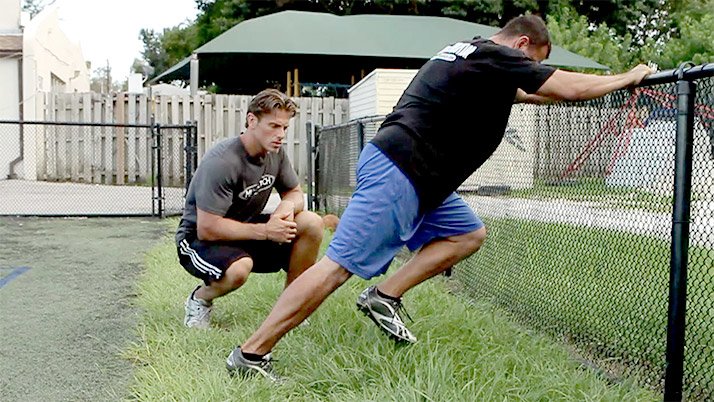
Step-By-Step
- Nice forward lean (45 degrees) against the wall/fence
- Feet together, push toe to the top of the shoe
- Get glutes to contract
- Lift one knee
- Drive straight down, attack the ground
- Switch legs, left, right slowly
- Then hammer it out rapid fire with feet
- Stop
- 3-5 seconds depending on progression of athlete
Assisted Sprint Series
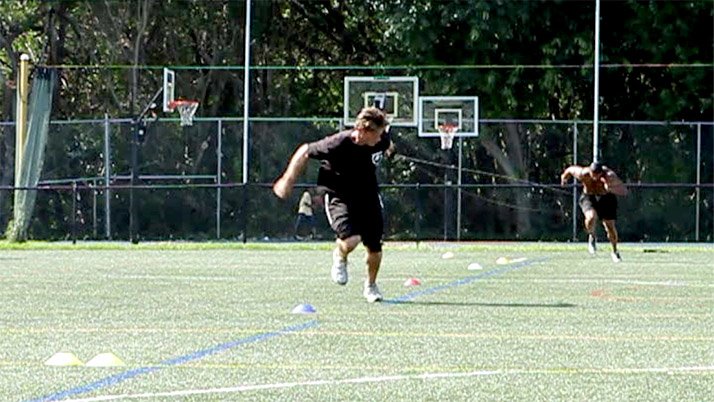
This is the most controversial topic in the industry. A lot of people shy away from it, because it's dangerous. A lot of people limit it because they're talking about research and force application.
I base my whole program around it. I think it is the most dangerous thing you can do, but I also think it can be the most effective.
Step-By-Step: Athlete Instructions
- You use a machine
- It's a pulley system
- It's not a stretching cord
- It's a straight cord, tied to the fence.
- Belt on an athlete
- Athlete is hooked to the belt by a karabiner
- The athlete will start 40 yards down
- The coach will be 30-40 yards away from him
- As soon as the athlete starts to move, the coach will start to run and pull him forward
- We'll decide how far we'll pull that athlete
- If he's going 40 yards, you want to pull him about 20 yards
It has to be a constant assistance, which is why you we use a pulley system as opposed to a bungee system.
It can only assist you in very minute levels above your maximum ability to run. On average you'll only see 3-7 percent assisted faster. The people who go against it talk about over-striding. Yes, over-striding could happen with this device if you don't micro-progress into it.
When I say that I mean the Moving Claw series, again, is the exercise. If you can master that and complex it back and forth between the actual assisted running itself, then you can be effective.
Step-By-Step: Coach Instructions
- I'm down, holding the cord
- The athlete will move out of his 2-point stance
- I'll start to sprint with that athlete
- I'll pull him so many yards
- Then I'll rip the cord off
- The athlete will be propelled in an over-speed training manner forward
Once you've done the over-speed running, you have to do a lot of neuro-muscular work right after it, as well as get back into those moving claw series, and so on. I like to "complex" back and forth.
It's the most effective horizontal plyometric you can possibly do because of the rapid-stretch reflex occurring in the posterior chain. Not only do we do it with our combine athletes, we do it with all our veterans. I think we understand how to teach that speed.
Linear 3-Part Start Technique

It is trying to get you into position to ...
- Go within the rules of the NFL combine
- Allow you, without any pausing or decelerating steps, to get into your drive, your acceleration phase as quickly as possible.
Step-By-Step: Lower Half of Body
- Two feet on the line: toe to ankle bone
- Right foot: 4-6 inches
- The right hand is going to come right in the line
- Left hand: on fingertips
- Nose to the knee
- Load the left leg
- Contract the right glute
- Left hand up
- ... one thousand one ...
- ... one thousand two ...
- Fire out!
You have to load the front knee with the shin angle as low to the ground as possible to try to mimic that same type of drive shin angle when you come out. It's got to be a 2-foot jump, which is why you see us load the back foot without straightening the knee.
Step-By-Step: Upper Half of Body
- Block the sun
- Fire the elbow
I believe the arm up serves as a powerful lever forward, which is why we straighten the arm, so once the down-action of that arm comes down, you can actually come out. You flip the arm up to almost block the sun out of your eyes. When you flip and rotate your hand, it can act as a powerful stretch-reflex lever to propel your upper body into proper position.
It's an aggressive technique. The hardest part is after you get the powerful jump. Can you accelerate out? It's very difficult to teach to a football player because they don't have that track background. I think with assisted running complex, with this technique, it can be very effective. If you really want o maximize your gains, doing those two things will achieve it.
Kneeling Arm Drill
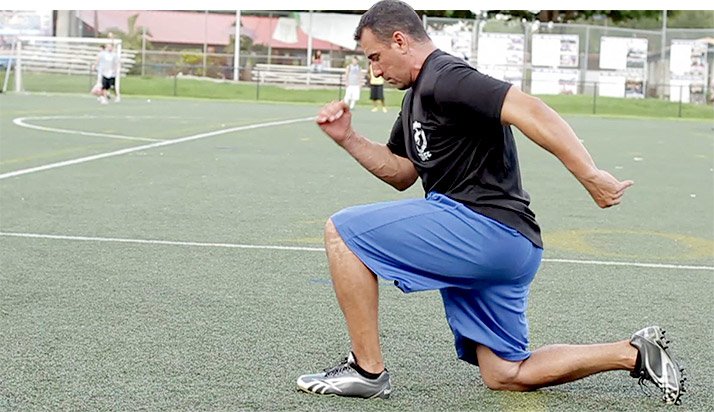
In all running motions, the arms lead the legs. If you can increase the efficiency of the strength-reflex properties of the arm, you can increase the efficiency of the stretch-reflex properties of the legs.
Step-By-Step
- Left foot in front
- Right knee down
- Engage
- Keep head down
- Start a long, pendulum arm swing
- Start to jog (arms only)
- Start to run (arms only)
- Start to sprint (arms only)
- Force reduction stretch reflex (hand-clearing the hip)
- Switch Knees: Put your body in a good position to completely eliminate the legs and focus on that upper-body type of action. There's no better way to do that than the kneeling-drill series.
4 Components
- Start with long levers
- Slowly progress into jog
- Slowly progress into run
- Mimic how efficient your arms can run
- Takes the legs away
- Doesn't fatigue the legs
If you have good arm action, it might help propel your legs (which might be in a fatigue-state) into proper mechanics.
Why 40-yard Dash?
It tells us pure athleticism in a linear sense. People who say "the 40-yard dash isn't very specific," "you're not changing directions," "in football you never run a straight line" ... that's all ridiculous to me.
It's pure athleticism. When you look at the components of accelerating and transitioning and you look at the muscle action that is involved in the cyclical action of that finish, you're looking at the explosive reflex properties of those muscles.
Why can't they just look at my game film?
How are you supposed to gauge someone's true speed if they're always playing hurt on tape? You want to take that measuring tool of athleticism and if you can display that in addition to solid game tape, you just enhance your draft stock.
If you look at all the exercises we've performed at Bommarito Performance that are displayed in this football training series, we're not leaving anything out. That's the main thing.
You're looking at start, first step, acceleration, transition, finish, arm action, head position, everything. There are so many different variables in terms of that 40 yards that could go wrong, you want to make sure you have competent training drills to be able to enhance each and every variable. That's what we've done with the exercises we've provided.
Incorporate these exercises into your program to maximize your performance in the 40. Check out the entire series on bodybuilding.com.


